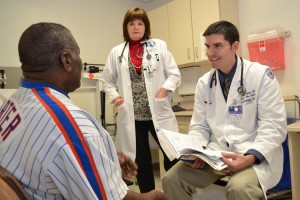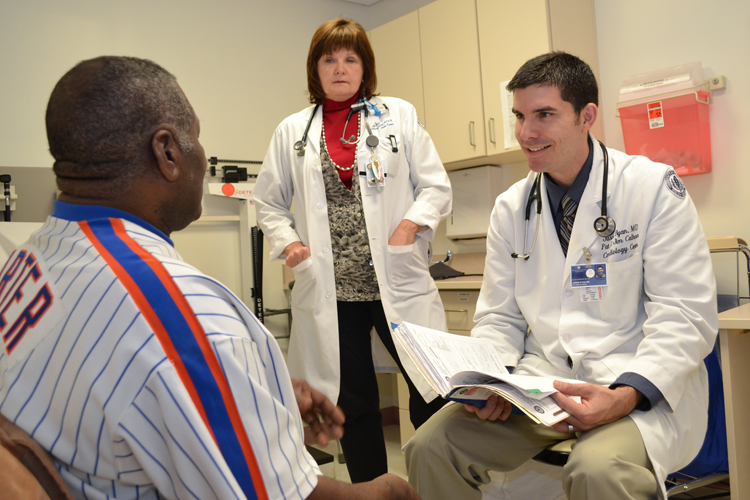
The Health Center’s efforts to reduce the number of heart failure patients readmitted to the hospital have dramatically paid off. Between February 2010 and October 2011, the Health Center’s readmission rate for patients with heart failure decreased from 26.1 percent to 20.4 percent. According to the Connecticut Hospital Association, that is well below the statewide average of 25.9 percent.
Each year, nearly five million people living in the United States are hospitalized repeatedly with heart failure. It is the most common reason people are readmitted to U.S. hospitals.
“Patients and families dread the multiple hospital admissions that they must go through if someone has heart failure,” says Dr. Jason Ryan, co-director of the UConn Heart Failure Center. “We are trying to become the regional leader in maintaining a low rate of hospitalization among our heart failure population.”
Ryan credits the success to a hospital-wide effort involving numerous departments and health care practitioners. He says the quality improvement interventions began in 2009 when the Health Center created the Heart Quality Team (HQT) to improve the care of heart failure patients throughout the institution.
The primary goal was to improve the transition of care from the hospital to the patient’s home and lower the 30-day all-cause readmission rate. The HQT also joined a statewide effort in February 2010 led by Qualidigm, a patient safety organization, to reduce heart failure readmissions. As part of this collaborative, HQT members attended seminars and received quarterly feedback on the hospital’s progress in lowering rates of readmission.
The HQT identified heart failure patients on a daily basis using a computer-generated list of inpatients receiving diuretics—medications commonly prescribed to heart failure patients. This technique successfully pared down the entire hospital population (220+ patients) to a more manageable list (20 to 30 patients) that was likely to have heart failure. Charts for each of these patients were reviewed to identify those individuals with heart failure. The team created a daily email of the entire hospital population of heart failure patients to notify nurse managers, social workers, physicians, and other key staff.
Targeted interventions to improve the transition of care were then provided to each heart failure patient. Heart failure teaching (low-salt eating, daily weights, medication compliance) was performed by the patient’s floor nurse with reinforcement as needed by a heart failure nurse practitioner. Staff from nutrition, pharmacy, and social work also met with each patient. A seven-day follow-up appointment was scheduled prior to discharge for every patient, often with the same physician or nurse practitioner who cared for the patient in the hospital. Follow-up phone calls were conducted 48 to 72 hours after discharge.
Ryan says they also formed a team of community service providers including skilled nursing facilities, visiting nurse associations, and insurance providers. This team met monthly to discuss care for heart failure patients. Topics included communication between community providers and physicians as well as standardized teaching tools for heart failure education.
The Health Center has become a leader in this area. In February, it hosted a Heart Failure Symposium: Care Across the Continuum. It attracted nearly 250 participants from hospitals, nursing homes, and long term care facilities throughout the state.
A series of “Heart Talk” videos featuring Ryan have been produced by Qualidigm with the goal of offering straightforward and consistent information about heart failure (see sidebar for more information). The target audience for the videos includes patients and their families as well as licensed and non-licensed health care providers.
‘HeartTalk’ Video Series Aims to Reduce Costly National Trend
A series of videos on heart failure featuring the Health Center’s Dr. Jason Ryan has been produced by Qualidigm, a health care consulting and research organization in Rocky Hill. The Heart Talk videos focus on the key recommendations that, if followed, can help patients with heart failure live a healthier life without unnecessary hospitalizations. Ryan, assistant professor of medicine and co-director of the Calhoun Cardiology Center’s Heart Failure Center, serves as narrator.
“Many of the hospitalizations for heart failure we think are avoidable if patients have better education, and that often slips through the cracks. Providers are so busy ordering the tests and treatments that everyone forgets to sit down at the bedside for 20 minutes and go over all the things patients can do to help themselves,” explains Ryan. “We were shocked that there is not a universal set of teaching materials that everybody can use, and that there’s not an easily accessible set of videos that have highlights about what heart failure is.”
The three-part video series is made possible by funding from the Centers for Medicare & Medicaid Services. The first video is for licensed healthcare professionals; the second is for nursing assistants; the third is for patients, families and caregivers.
Follow the UConn Health Center on Facebook, Twitter and YouTube.



